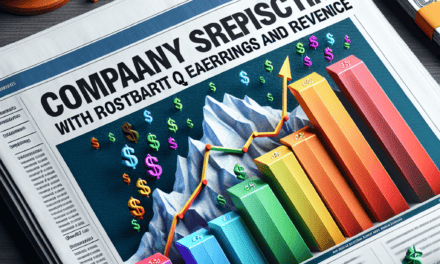“Exploring Costco’s Price Milestones: Past Insights and Future Forecasts.”
Introduction
In recent months, Costco’s stock has garnered significant attention as it approaches a price point not seen in years. This article delves into the historical context of Costco’s stock performance, examining the last time it reached this price level and the factors that influenced its trajectory. By analyzing past trends, market conditions, and consumer behavior, we aim to provide insights into what this price point could mean for investors and the company’s future. Additionally, we will explore expert predictions and potential scenarios that could shape Costco’s stock performance in the coming months.
Historical Performance of Costco Stock
Costco Wholesale Corporation, a leading player in the retail sector, has demonstrated remarkable resilience and growth over the years, making its stock a focal point for investors. To understand the current valuation of Costco stock, it is essential to examine its historical performance, which provides valuable insights into its trajectory and potential future movements. Historically, Costco’s stock has exhibited a consistent upward trend, characterized by periods of significant growth interspersed with market corrections.
In the early 2000s, Costco’s stock was relatively modest, reflecting the company’s steady but unspectacular growth. However, as the company expanded its footprint both domestically and internationally, investor confidence began to rise. By the mid-2000s, Costco’s stock price had begun to reflect its robust business model, which emphasizes low prices and high-quality products. This model not only attracted a loyal customer base but also positioned Costco favorably against competitors in the retail space. As a result, the stock experienced a notable increase, particularly during the economic recovery following the 2008 financial crisis.
Transitioning into the 2010s, Costco’s stock performance continued to impress, driven by a combination of strategic initiatives and favorable market conditions. The company’s commitment to enhancing the shopping experience, including the expansion of its e-commerce capabilities, played a crucial role in attracting new members and retaining existing ones. Consequently, Costco’s stock reached new heights, reflecting the company’s ability to adapt to changing consumer preferences and market dynamics. This period also saw Costco benefiting from a broader trend of consumers gravitating towards membership-based retail models, further bolstering its stock performance.
As we move into the latter part of the decade, Costco’s stock faced challenges, particularly during periods of market volatility. However, the company’s fundamentals remained strong, and its ability to maintain steady revenue growth helped mitigate the impact of external pressures. Notably, during the COVID-19 pandemic, Costco emerged as a critical player in the retail landscape, with increased demand for essential goods and a surge in membership sign-ups. This unprecedented situation not only reinforced the company’s value proposition but also propelled its stock to new heights, as investors recognized the resilience of Costco’s business model in times of crisis.
Looking ahead, the historical performance of Costco stock provides a foundation for future predictions. Analysts often point to the company’s strong balance sheet, consistent revenue growth, and commitment to innovation as key factors that will likely support its stock price in the coming years. Furthermore, as the retail landscape continues to evolve, Costco’s ability to adapt and leverage technology will be crucial in maintaining its competitive edge. The company’s ongoing investments in digital infrastructure and supply chain optimization are expected to enhance operational efficiency and customer satisfaction, which could translate into sustained stock performance.
In conclusion, the historical performance of Costco stock reveals a narrative of resilience, adaptability, and growth. By examining past trends and understanding the factors that have influenced its trajectory, investors can gain valuable insights into the potential future of Costco’s stock. As the company continues to navigate the complexities of the retail environment, its strong fundamentals and strategic initiatives position it well for continued success, making it a stock worth monitoring for both current and prospective investors.
Key Factors Influencing Costco’s Stock Price
Costco’s stock price is influenced by a myriad of factors that reflect both the company’s operational performance and broader economic conditions. Understanding these key elements is essential for investors and analysts alike, as they provide insight into the potential future trajectory of the stock. One of the primary drivers of Costco’s stock price is its financial performance, particularly its revenue growth and profitability. The company has consistently demonstrated strong sales figures, largely due to its membership-based business model, which fosters customer loyalty and repeat purchases. As more consumers gravitate towards bulk buying and value-oriented shopping, Costco’s ability to attract and retain members becomes increasingly significant. This trend not only bolsters revenue but also enhances investor confidence, often resulting in a positive impact on stock prices.
In addition to operational performance, macroeconomic factors play a crucial role in shaping Costco’s stock price. Economic indicators such as consumer spending, inflation rates, and employment levels can significantly influence retail performance. For instance, during periods of economic expansion, consumers are more likely to spend, which can lead to increased foot traffic in Costco warehouses and higher sales volumes. Conversely, during economic downturns, consumers may tighten their budgets, potentially affecting Costco’s sales. However, it is worth noting that Costco has historically shown resilience during economic fluctuations, as its value proposition often attracts budget-conscious shoppers even in challenging times. This resilience can serve as a stabilizing factor for its stock price, making it an attractive option for investors seeking stability.
Moreover, competition within the retail sector is another critical factor that influences Costco’s stock price. The rise of e-commerce giants, particularly Amazon, has transformed the retail landscape, compelling traditional retailers to adapt their strategies. Costco has responded by enhancing its online presence and offering services such as same-day delivery and curbside pickup. These initiatives not only cater to changing consumer preferences but also help Costco maintain its competitive edge. As the company continues to innovate and expand its service offerings, investor sentiment may improve, positively impacting the stock price.
Furthermore, external factors such as supply chain dynamics and global economic conditions can also affect Costco’s stock performance. The COVID-19 pandemic, for example, highlighted the vulnerabilities in global supply chains, leading to increased costs and inventory challenges for many retailers, including Costco. However, the company’s robust supply chain management and strategic sourcing have allowed it to navigate these challenges effectively. As the global economy stabilizes and supply chain issues are addressed, Costco’s operational efficiency may enhance, further supporting its stock price.
Lastly, investor sentiment and market trends cannot be overlooked when considering the factors influencing Costco’s stock price. Market perceptions, driven by news, analyst ratings, and broader market movements, can lead to fluctuations in stock prices that may not always align with the company’s fundamental performance. As investors react to both internal and external stimuli, the interplay between market psychology and Costco’s operational realities becomes evident.
In conclusion, the key factors influencing Costco’s stock price encompass a blend of financial performance, macroeconomic conditions, competitive dynamics, supply chain management, and investor sentiment. By understanding these elements, stakeholders can better navigate the complexities of Costco’s stock and make informed decisions regarding their investments. As the company continues to adapt to changing market conditions, its ability to sustain growth and profitability will remain pivotal in shaping its future stock performance.
Comparison with Competitors During Price Peaks
When analyzing the performance of Costco stock, particularly during its price peaks, it is essential to consider how it compares with its competitors in the retail sector. The last time Costco shares reached a significant price point, the competitive landscape was markedly different, yet certain trends remained consistent. Understanding these dynamics not only sheds light on Costco’s market position but also provides insights into potential future performance.
During previous price peaks, Costco’s primary competitors, such as Walmart and Target, exhibited varying strategies that influenced their stock valuations. For instance, Walmart, with its vast network of supercenters and a strong online presence, often capitalized on its scale to offer lower prices. This aggressive pricing strategy has historically pressured Costco, which operates on a membership model that emphasizes value over sheer volume. However, Costco’s unique approach to customer loyalty and its ability to maintain a steady membership renewal rate have allowed it to weather competitive storms effectively.
Moreover, Target’s focus on enhancing the shopping experience through store redesigns and exclusive product lines has also posed challenges for Costco. While Target has invested heavily in creating a more appealing in-store environment, Costco has remained steadfast in its no-frills approach, prioritizing bulk sales and low prices. This divergence in strategy highlights how Costco’s business model, which relies on high volume and low margins, can be both a strength and a vulnerability during periods of intense competition.
As Costco’s stock reached its previous peak, the broader economic environment played a crucial role in shaping investor sentiment. Economic indicators such as consumer spending, inflation rates, and employment figures directly impact retail performance. For instance, during times of economic uncertainty, consumers often gravitate towards discount retailers, which can benefit Costco. This trend was evident during the last peak, as Costco’s sales surged amid rising inflation, prompting consumers to seek value in bulk purchases. In contrast, competitors like Walmart and Target faced challenges in maintaining their margins, as they struggled to balance price competitiveness with rising operational costs.
Transitioning to the present, it is vital to consider how these competitive dynamics may evolve in the future. With the rise of e-commerce, all retailers, including Costco, are adapting to a rapidly changing landscape. While Costco has made strides in enhancing its online shopping experience, it still lags behind competitors like Amazon in terms of digital sales. This gap presents both a challenge and an opportunity for Costco as it seeks to capture a larger share of the online market. If Costco can successfully integrate its membership model with a robust e-commerce platform, it may not only sustain its stock price during future peaks but also outperform its competitors.
In conclusion, the comparison of Costco with its competitors during previous price peaks reveals a complex interplay of strategies and market conditions. While Costco has consistently leveraged its membership model to drive customer loyalty, the competitive landscape remains dynamic. As the retail sector continues to evolve, Costco’s ability to adapt to changing consumer preferences and technological advancements will be critical in determining its future stock performance. Investors should remain vigilant, as the lessons learned from past price peaks can provide valuable insights into the potential trajectory of Costco stock in the years to come.
Analyst Predictions for Costco’s Future Growth
As Costco continues to navigate the complexities of the retail landscape, analysts are closely monitoring its stock performance and future growth potential. The last time Costco’s stock reached a significant price point, it was indicative of broader market trends and consumer behavior that have since evolved. Analysts are now tasked with predicting how these factors will influence Costco’s trajectory in the coming years.
One of the primary drivers of Costco’s growth is its unique business model, which emphasizes membership-based shopping. This model not only fosters customer loyalty but also allows the company to maintain competitive pricing on a wide range of products. Analysts note that as inflationary pressures persist, consumers are increasingly drawn to value-oriented retailers like Costco. This trend is expected to bolster membership renewals and attract new members, thereby enhancing revenue streams. Furthermore, the company’s ability to offer high-quality products at lower prices positions it favorably against traditional retailers, which may struggle to compete in a price-sensitive environment.
In addition to its robust membership model, Costco’s expansion strategy plays a crucial role in its growth outlook. The company has consistently opened new warehouses, both domestically and internationally, which has contributed to its revenue growth. Analysts predict that this expansion will continue, particularly in underpenetrated markets where Costco has the potential to capture significant market share. As the company increases its footprint, it is likely to benefit from economies of scale, further enhancing its competitive advantage.
Moreover, Costco’s commitment to e-commerce is another factor that analysts believe will drive future growth. The pandemic accelerated the shift toward online shopping, and Costco has responded by enhancing its digital capabilities. Analysts are optimistic that the company’s investments in technology and logistics will enable it to compete more effectively in the e-commerce space. As consumers increasingly seek the convenience of online shopping, Costco’s ability to provide a seamless omnichannel experience will be critical to attracting and retaining customers.
In terms of financial performance, analysts are generally bullish on Costco’s prospects. The company’s consistent revenue growth, strong balance sheet, and healthy cash flow position it well for future investments and shareholder returns. Many analysts project that Costco will continue to deliver solid earnings growth, driven by both its core business and strategic initiatives. This positive outlook is reflected in the stock’s performance, as investors remain confident in Costco’s ability to navigate economic challenges and capitalize on growth opportunities.
However, it is essential to consider potential risks that could impact Costco’s future growth. Supply chain disruptions, rising labor costs, and increased competition from both traditional retailers and e-commerce giants pose challenges that the company must address. Analysts emphasize the importance of Costco’s agility in adapting to these challenges while maintaining its value proposition.
In conclusion, while the last time Costco’s stock reached a notable price point may serve as a historical reference, the future holds promising potential for the company. Analysts are optimistic about Costco’s growth trajectory, driven by its unique business model, expansion strategy, and commitment to e-commerce. As the retail landscape continues to evolve, Costco’s ability to adapt and innovate will be crucial in sustaining its competitive edge and delivering value to its shareholders.
Economic Indicators Impacting Retail Stocks
The performance of retail stocks, including those of major players like Costco, is significantly influenced by a variety of economic indicators. Understanding these indicators is crucial for investors seeking to navigate the complexities of the stock market. One of the primary economic indicators impacting retail stocks is consumer confidence. When consumers feel optimistic about their financial situation, they are more likely to spend money, which directly benefits retailers. Conversely, a decline in consumer confidence can lead to reduced spending, negatively affecting retail stock prices.
Another important economic indicator is the unemployment rate. A low unemployment rate typically correlates with increased disposable income, allowing consumers to spend more freely. This is particularly relevant for Costco, which operates on a membership-based model that thrives on high-volume sales. When employment levels are stable or improving, Costco often sees an uptick in membership renewals and new sign-ups, which can bolster its stock performance. On the other hand, rising unemployment can lead to decreased consumer spending, prompting investors to reassess the potential growth of retail stocks.
Inflation also plays a critical role in shaping the landscape for retail stocks. When inflation rates rise, the cost of goods increases, which can squeeze profit margins for retailers. For Costco, which prides itself on offering low prices to its members, maintaining competitive pricing during inflationary periods can be challenging. If Costco is unable to pass on increased costs to consumers without losing sales, its profitability may suffer, leading to a potential decline in stock value. Therefore, monitoring inflation trends is essential for investors looking to gauge the future performance of Costco and similar retail stocks.
Interest rates are another economic factor that can influence retail stocks. When interest rates are low, borrowing costs decrease, encouraging both consumers and businesses to spend more. This environment can lead to increased sales for retailers like Costco, as consumers are more likely to finance larger purchases. Conversely, rising interest rates can dampen consumer spending, as higher borrowing costs may lead to reduced disposable income. As a result, investors must keep a close eye on central bank policies and interest rate movements to understand their potential impact on retail stock performance.
Additionally, macroeconomic trends such as GDP growth can provide insights into the overall health of the economy and its effect on retail stocks. A growing economy typically leads to increased consumer spending, which can benefit retailers. For Costco, strong GDP growth can translate into higher sales volumes and improved stock performance. However, if economic growth slows or contracts, retailers may face challenges that could negatively impact their stock prices.
In conclusion, the interplay of various economic indicators significantly influences the performance of retail stocks, including Costco. Consumer confidence, unemployment rates, inflation, interest rates, and GDP growth all play pivotal roles in shaping the retail landscape. As investors look to the future, understanding these economic indicators will be essential for making informed decisions regarding Costco stock and the broader retail sector. By keeping abreast of these factors, investors can better anticipate market trends and position themselves for potential opportunities or challenges that may arise in the ever-evolving retail environment.
Investor Sentiment and Its Effect on Costco’s Valuation
Investor sentiment plays a crucial role in shaping the valuation of publicly traded companies, and Costco is no exception. As one of the leading wholesale retailers, Costco’s stock price is influenced not only by its financial performance but also by the perceptions and emotions of its investors. Understanding how investor sentiment affects Costco’s valuation requires a closer examination of market dynamics, economic indicators, and consumer behavior.
To begin with, investor sentiment is often driven by broader economic conditions. When the economy is thriving, consumer spending typically increases, which can lead to higher sales and profits for retailers like Costco. In such an environment, investors may feel more optimistic about the company’s future prospects, resulting in increased demand for its stock. Conversely, during economic downturns, investor sentiment can shift dramatically. Concerns about rising unemployment, inflation, or geopolitical tensions can lead to a more cautious approach, causing investors to reassess their positions and potentially sell off shares. This reaction can create downward pressure on Costco’s stock price, regardless of the company’s underlying fundamentals.
Moreover, investor sentiment is also influenced by Costco’s performance relative to its competitors. In a highly competitive retail landscape, any signs of weakness or underperformance can lead to negative sentiment among investors. For instance, if rival companies report stronger sales growth or innovative strategies that capture market share, investors may become skeptical about Costco’s ability to maintain its competitive edge. This skepticism can manifest in a decline in stock price, even if Costco continues to post solid financial results. Therefore, it is essential for Costco to not only focus on its internal performance metrics but also to remain vigilant about industry trends and competitor actions.
In addition to economic conditions and competitive dynamics, investor sentiment can be swayed by external events and news cycles. For example, announcements regarding changes in management, shifts in corporate strategy, or significant investments can all impact how investors perceive Costco’s future. Positive news, such as the opening of new stores or successful product launches, can bolster investor confidence and drive stock prices higher. On the other hand, negative news, such as supply chain disruptions or regulatory challenges, can lead to a swift decline in sentiment, prompting investors to reevaluate their positions.
Furthermore, the rise of social media and online trading platforms has amplified the impact of investor sentiment on stock prices. Retail investors now have greater access to information and can quickly react to news and trends, often leading to rapid fluctuations in stock valuations. This phenomenon can create volatility in Costco’s stock price, as collective sentiment shifts in response to market chatter or viral trends. Consequently, understanding the nuances of investor sentiment has become increasingly important for stakeholders looking to navigate the complexities of Costco’s valuation.
Looking ahead, it is essential for investors to consider how sentiment may evolve in response to changing economic conditions, competitive pressures, and external events. While Costco has a strong track record of resilience and adaptability, the interplay between investor sentiment and its valuation will continue to be a critical factor in determining its stock price trajectory. As such, maintaining a keen awareness of market sentiment and its implications will be vital for investors seeking to make informed decisions regarding Costco’s stock in the future. Ultimately, the relationship between investor sentiment and Costco’s valuation underscores the importance of a holistic approach to investment analysis, one that considers both quantitative metrics and qualitative factors.
Lessons Learned from Past Stock Price Movements
The fluctuations in Costco’s stock price over the years provide valuable insights into the dynamics of the retail sector and the broader market. Understanding these movements can help investors make informed decisions about future investments. One of the most significant lessons learned from past stock price movements is the importance of consumer behavior and economic conditions. For instance, during economic downturns, consumers often gravitate towards discount retailers, which can lead to increased sales and, consequently, a rise in stock prices for companies like Costco. This trend was evident during the 2008 financial crisis when Costco’s stock demonstrated resilience compared to its competitors, highlighting the company’s ability to adapt to changing consumer needs.
Moreover, the impact of external factors such as inflation and supply chain disruptions cannot be overlooked. For example, when inflation rates rise, consumers tend to become more price-sensitive, which can benefit Costco’s business model centered around offering bulk products at competitive prices. In the past, periods of high inflation have often correlated with increased sales for Costco, leading to stock price appreciation. This relationship underscores the necessity for investors to monitor macroeconomic indicators closely, as they can significantly influence stock performance.
Another critical lesson is the role of strategic expansion and innovation in driving stock price growth. Costco’s commitment to opening new warehouses and enhancing its e-commerce capabilities has historically contributed to its stock price increases. The company’s ability to adapt to the digital landscape, particularly during the COVID-19 pandemic, showcased its resilience and forward-thinking approach. As more consumers shifted to online shopping, Costco’s investments in technology and logistics allowed it to capture a larger market share, reinforcing the idea that companies that innovate and expand strategically are often rewarded in the stock market.
Additionally, understanding the competitive landscape is essential for evaluating Costco’s stock price movements. The retail sector is characterized by intense competition, and Costco’s ability to maintain its market position against rivals such as Walmart and Amazon is a testament to its strong brand loyalty and customer satisfaction. Historical data indicates that periods of increased competition can lead to stock price volatility; however, Costco’s unique membership model and focus on customer experience have often allowed it to weather these storms more effectively than its competitors. This highlights the importance of brand strength and customer loyalty in sustaining stock performance.
Furthermore, investor sentiment plays a crucial role in stock price movements. Market perceptions can sometimes lead to overreactions, resulting in stock price fluctuations that do not necessarily reflect the underlying fundamentals of the company. For instance, during times of economic uncertainty, investors may sell off stocks, including Costco, despite the company’s strong performance metrics. This phenomenon illustrates the need for investors to remain grounded in fundamental analysis rather than succumbing to market hysteria.
In conclusion, the lessons learned from Costco’s past stock price movements emphasize the significance of understanding consumer behavior, economic conditions, strategic innovation, competitive dynamics, and investor sentiment. By analyzing these factors, investors can better navigate the complexities of the stock market and make more informed decisions regarding their investments in Costco and similar retail companies. As the market continues to evolve, these insights will remain relevant, guiding investors toward potential opportunities and risks in the future.
Q&A
1. **What was the last price point Costco stock reached that is significant?**
The last significant price point for Costco stock was $500 per share.
2. **When did Costco stock last reach this price?**
Costco stock last reached this price in early 2023.
3. **What factors contributed to Costco stock reaching this price?**
Factors included strong earnings reports, increased consumer demand, and expansion of membership services.
4. **How did the stock perform after reaching this price?**
After reaching this price, Costco stock experienced fluctuations but generally maintained a positive trend.
5. **What are analysts predicting for Costco stock in the future?**
Analysts predict continued growth, with potential price targets ranging from $520 to $550 in the next 12 months.
6. **What economic conditions could impact Costco’s stock price?**
Economic conditions such as inflation rates, consumer spending trends, and supply chain issues could impact Costco’s stock price.
7. **How does Costco’s business model support its stock price stability?**
Costco’s membership-based model, bulk purchasing strategy, and focus on low prices contribute to its revenue stability and stock price resilience.
Conclusion
In conclusion, the last time Costco stock reached this price marked a significant moment in the company’s financial history, reflecting its resilience and growth potential. Analyzing past performance, market conditions, and consumer trends suggests that while there may be short-term fluctuations, Costco’s strong fundamentals and strategic positioning indicate a promising outlook for future stock performance. Investors should remain optimistic but vigilant, considering both historical patterns and evolving market dynamics.





